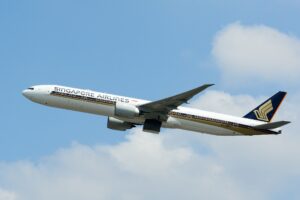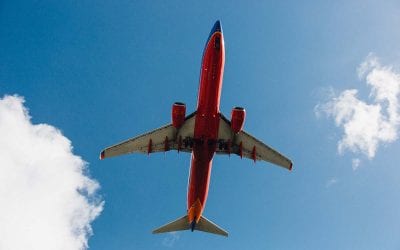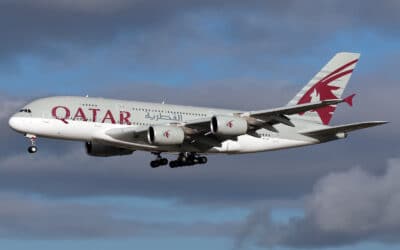Air travelers never know when severe air turbulence can hit their flight. The top safety rule all airline passengers must follow is that whenever seated, they must always wear their seat belts to prevent severe turbulence injury.
 On May 20th, Singapore Airlines flight SQ321 was headed from London’s Heathrow Airport on its 12-plus hour flight to Singapore’s Changi Airport. There were a total of 211 passengers and 18 crew members on board the Boeing 777–300ER jetliner.
On May 20th, Singapore Airlines flight SQ321 was headed from London’s Heathrow Airport on its 12-plus hour flight to Singapore’s Changi Airport. There were a total of 211 passengers and 18 crew members on board the Boeing 777–300ER jetliner.
The flight was cruising at 37,000 feet, about 10 hours into the flight, while over the Irrawaddy Basin when it encountered severe turbulence. When looking at the data available on Flight Radar 24, it appears that the plane dropped 6,000 feet in about four minutes, a descent of about 1,500 feet per minute. The plane was in the middle of meal service, with many of the passengers enjoying breakfast at the time of the incident.
On Singapore Airlines flight SQ321, there were 104 injured and one death due to severe air turbulence.
The pilot declared a medical emergency and diverted the flight to Bangkok Suvarnabhumi Airport. In the end, there were a total of 104 injuries among the 229 on the flight, with one death, a 73-year-old male British citizen. That’s almost half the passengers and crew. Samitivej Srinakarin Hospital said that 71 people had been treated there, with at one point at least 20 in intensive care. The hospital added that among the injured, 22 had spinal injuries.
Andrew Davis was a passenger on the flight who was interviewed by Erin Burnett on CNN. He said that while he was watching a movie, the seat belt sign lighted up. He told Ms. Burnett that he fastened his seat belt at that time. He said, “Thank goodness I did, because within moments of doing that, all hell broke loose.” He said the plane felt like it dropped.
A passenger on the flight recalled seeing all kinds of gear flying throughout the plane’s cabin due to the severe turbulence.

Just seven days later, last week, 12 more people were injured due to severe turbulence. They were flying on Qatar Airways Flight 017 from Doha to Dublin on a Boeing 787 Dreamliner. While over Turkey, according to reports, the plane dropped about 400 feet in about a minute, approximately an hour into the flight that was flying at an altitude of 33,000 feet. Emergency services met the flight in Dublin. The injured included six passengers and six crew members. Eight of the injured were taken to the hospital.
I’ve been a passenger on several flights encountering severe turbulence but was not injured because I wore my seat belt. It saved me.
Over the years, I’ve been on several flights that encountered severe turbulence. On one particular flight, had I not been wearing my seat belt snugly, the severe turbulence would have forcefully thrown me against the ceiling of the plane, like three passengers on my flight who all sustained head injuries. They didn’t follow our flight attendant’s instructions to put on and tighten their seat belts when the seat belt light came on. I saw them bleeding from head wounds. Each was treated when we landed.
Had there been babies or toddlers held in their parents’ laps on my flight, I have no doubt that the children would have been severely injured and in need of hospitalization. No parent can successfully hold onto a child during severe turbulence. Fortunately, there weren’t any children on the flight.
A scientific study predicts that climate change will increase windshear that causes severe air turbulence from 17 to 29 percent by the end of the century.
Turbulence is generated by eddies in the atmosphere, windshears, concentrated mostly in jet streams. According to a study by Dr. Paul Williams, professor of Atmospheric Science at the University of Reading, et. al., the increase of windshear in jet streams is consistent with the expected effects of climate change and is expected to increase from 17 to 29 percent by the end of the century.
Dr. Williams stated in an article that,
“Turbulence strong enough to pose an injury risk could double or triple in frequency.”
In their August 2021 Safety Research Report, “Preventing Turbulence-Related Injuries in Air Carrier Operations…,” the NTSB (National Transportation Safety Board) explained that from 2009 through 2018, turbulence-related accidents accounted for more than a third of all regularly scheduled air carrier accidents, with most of them resulting in one or more serious injuries.
The NTSB has recommended many measures to improve forecasting of and preparation for severe air turbulence.
The NTSB issued safety recommendations for “improving weather forecasting, dissemination of weather reports, and air traffic management practices.” They also issued recommended improvements dissemination of pilot weather reports. These are essential for airlines’ and pilots’ route planning, for air traffic controllers to keep air traffic flowing safely, and for meteorologists to verify and amend aviation weather forecasts and advisories for safe flying.
If you take no other precaution to prevent being injured from severe air turbulence while in the air, wear your seat belt snugly throughout your flight whenever seated or lying down in your seat.
While the entire airline industry will do more over time to better forecast turbulence and determine where and when it can be avoided and/or better prepare passengers for it, for now it will remain a serious problem for airline passengers. Nevertheless, there are four commonsense rules every air traveler should follow to prevent being injured if severe turbulence occurs on their flight.
1. Fasten your seat belt:
The single most important action that you can take when flying is to fasten your seat belt snugly — but not so tight that it’s uncomfortable — whenever you’re seated during your flight, whether or not the seat belt sign is on. Often, there’s no warning severe turbulence will occur, so you must be prepared for turbulence at all times. Even when you’re lying down in a lie-flat seat, wear your seat belt snugly enough to be safe.
2. Babies and young children:
Even though children under the age of two may be legally held in a parent’s lap, all small children should be safely restrained in a standard seat/seat belt, in an approved child safety seat, appropriate for their age and size, and strapped to their own separate seat on the plane. Severe turbulence can exert as much force as 2½ Gs. No parent is capable of holding a child under that circumstance.
3. Stow your gear:
To prevent personal gear from becoming dangerous projectiles during severe air turbulence, all your travel gear when not in use, including games, tablets, cameras, laptop computers, etc., should be stowed in your carry-on or personal item.
4. Keep overhead bin doors closed:
After retrieving belongings from your carry-on stowed in an overhead bin, immediately re-close the bin’s door and latch it, as even mild turbulence can cause gear in the overhead bins to fall out onto passengers’ heads.

READ ASLO:
Passengers need an official DOT legal policy
Toddlers are vulnerable as recent FBI report shows airline sexual assaults soar
After many years working in corporate America as a chemical engineer, executive and eventually CFO of a multinational manufacturer, Ned founded a tech consulting company and later restarted NSL Photography, his photography business. Before entering the corporate world, Ned worked as a Public Health Engineer for the Philadelphia Department of Public Health. As a well known corporate, travel and wildlife photographer, Ned travels the world writing about travel and photography, as well as running photography workshops, seminars and photowalks. Visit Ned’s Photography Blog and Galleries.



